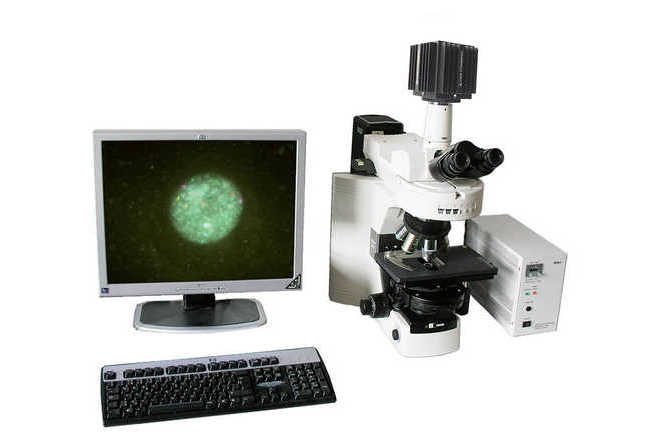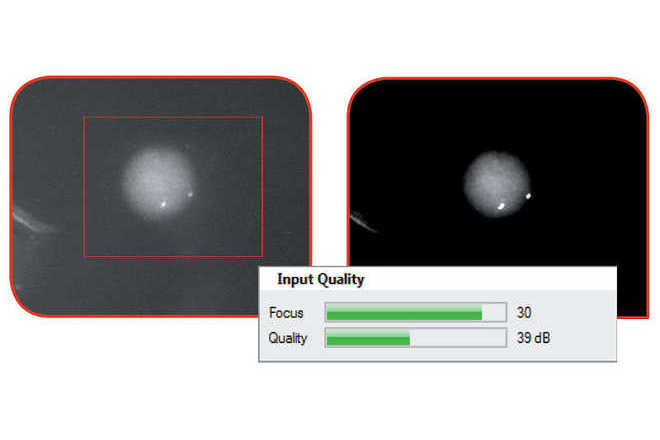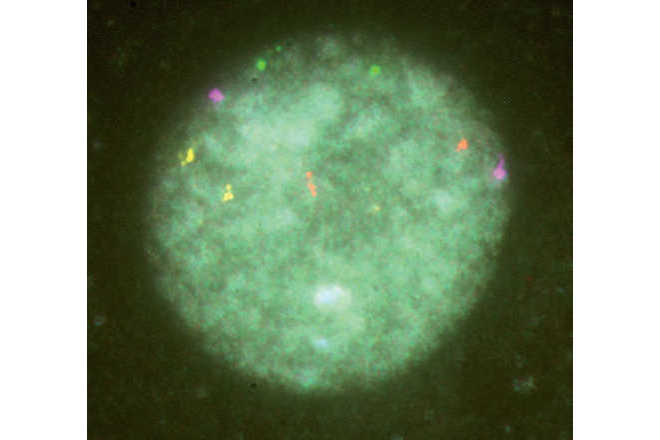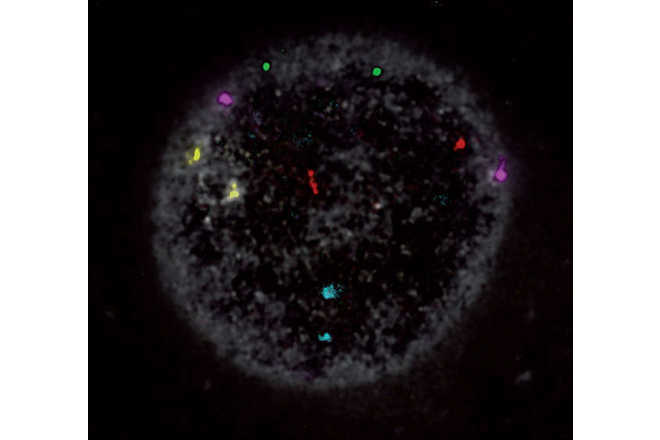is the genetic testing of preimplantation stage embryos for specific single gene disorders or heritable chromosomal imbalance. PGD for gender selection, aneuploidy, and structural abnormalities involves the biopsy of one or both polar bodies or the biopsy of one or two blastomeres (cells from 2 to 16 cell stage embryos), fixation to glass slides, followed by fluorescence in situ hybridization (FISH). One of the most critical steps in PGD is the fixation required to obtain good FISH nuclear quality without losing any of the cells analyzed.
Fluorescence in situ hybridization (FISH) is a technique that allows the visualization of specific nucleic acid sequences (specific chromosomal regions) within a cellular preparation. FISH involves the precise annealing of a single stranded fluorescently labeled DNA probe to complementary target sequences (to chromosomes or nuclei). The hybridization of the probe with the cellular DNA site is visible by direct detection using fluorescence microscopy.
Image Acquisition
-
High sensitive monochrome camera, optionally cooled, provides superb image quality and minimal signal fading.
-
The system can control motorized microscopes to make the work fast and efficient. Motorized shutters, filter turrets, external filter wheels connected to the system will dramatically improve the performance.
-
A motorized microscope stage can be used to record coordinates of points of interest and store them into a database. This way you can easily find the same coordinates later. Coordinate recalculation for multiple workstations (equipped with different tables) is performed automatically.
Image processing and analysis
-
Versatile image color display provides very simple probe-to-color assignment and various other settings.
-
Wide range of image processing and enhancement functions – contrast, region contrast, smart contrast, pixel shifts, color unmixing and many more.
-
Fast and flexible image annotation.
Image storage and reporting
-
Efficient and secure image storage based on the SQL database engine offers perfect fit to every imaginable laboratory workflow. There are many features: user defined database fields, various data types, comprehensive access rights, sorting, filtering and statistics, flexible data presentation.
-
Easy to use reporting tool offers outstanding results in minimum time. Automatic reporting uses templates allowing repeatable sequences for multiple data including images.
Numerical chromosome abnormalities are the major causation of inherited diseases with an incidence of 21% in spontaneous abortions. Of these, trisomies for gonosomes and chromosomes 21, 18, 16 and 13 account for 50% of chromosomaly abnormal abortions. Because of the correlation between aneuploidy and declining implantation rates with maternal age it was postulated that the screening of chromosome aneuploidies in human embryos by FISH using X, Y, 18, 13 and 21 probes should significantly reduce the risk of older IVF patients delivering trisomic offspring (Munne S., 2002). Currently, negative selection of aneuploid embryos can only be done through PGD. Conventional techniques for cytogenetic analysis usually depend on visualizing chromosomes in metaphase. This is not possible at preimplantation stage as a reliable karyotype cannot be obtained by spreading just one or two cells.
FISH allows chromosome enumeration to be performed on interphase cell nuclei, i.e. without the need for culturing cells or preparing metaphase spreads. . FISH has been applied to PGD of common aneuploidies using human blastomeres (or oocyte polar bodies). Mosaicism cannot be detected efficiently by PGD unless all cells lines are abnormal.
Vysis MultiVysion PGT and Vysis MultiVysion PB, two complementary DNA FISH reagents, are designed for detection of chromosome copy number in single cells such as human blastomere cells and polar body (DNA extruded from the ovum prior to and immediately following fertilization). MultiVysion PGT consists of a 5 probes with sequences homologous to specific regions on chromosomes 13,18, 21, X and Y, MultiVysion PB consists of probes for chromosomes 13, 16, 18, 21 and 22. Those reagents consist of DNA probes specific to chromosomes that are frequently identifies with abnormal copy number in polar bodies and in abnormal embryos, prior to implantation for IVF and can detect the most common chromosome abnormalities leading to spontaneous miscarriages and the birth of affected offspring (www.vysis.com).
Many laboratories investigate in their PGD program routinely chromosomes 13, 18, 21, X, Y (e.g. Vysis MultiVysion PGT) in human blastomeres. Routine investigation of chromosomes 16 and 22 in human blastomeres is also very common and profitable. Screening the chromosomes of preimplantation embryos using PGD techniques allows embryos with a high developmental potential (normal number of chromosomes) to be detected and used for IVF in preference to aneuploid embryos, thus increasing pregnancy rates.
-
Munne S. (2002): Preimplantation genetic diagnosis of numerical and structural chromosome abnormalities. Reproductive BioMedicine Online, 14726491, Vol 4, Issue 2.
-
Velilla E. et al. (2002): Blastomere fixation techniques and risk of misdiagnosis for preimplantation genetic diagnosis of aneuploidy. Reproductive BioMedicine Online, 14726491, Vol 4, Issue 3.
-
Wells D., Delhanty JDA (2001): Preimplantation genetic diagnosis: applications for molecular medicine. Trends in Molecular Medicine Vol.7 No. 1: 23-30.
-
Data from VysisTM and Laboratory ImagingTM products documentation were used in this leaflet.




